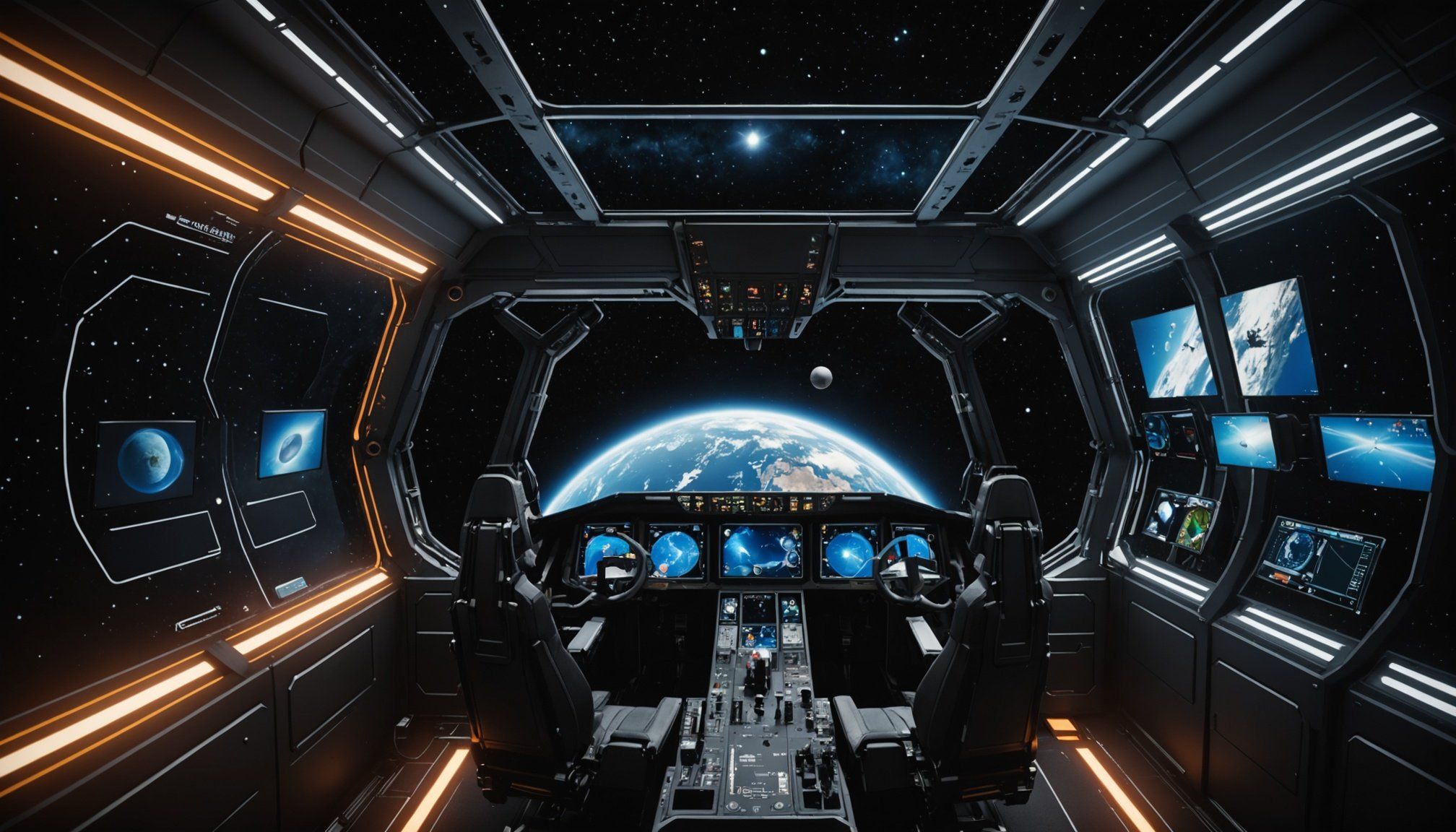The Importance of Realistic Physics in Space Simulation Games
Realistic physics play an essential role in creating believable environments in space simulation games. Accurate simulations of gravitational forces, object motion, and environmental interactions allow players to fully immerse themselves in the game world. This immersion is crucial for a gaming experience that feels authentic and engaging.
Player engagement is significantly enhanced when players interact with a universe that mirrors real-world physics. The trajectory of a spaceship, the gravitational pull of celestial bodies, or the thrilling sensation of a crash landing—each element becomes a captivating experience when rooted in the laws of physics. Such immersive gameplay keeps players invested, inviting them to explore and participate actively within the game.
Also read : Unlocking the Future of Education with Immersive VR: Essential Elements for Transformative Learning Journeys
Successful space simulation games, like “Kerbal Space Program” and “Elite Dangerous,” exemplify how realistic physics can be seamlessly integrated. These titles have effectively used accurate physics to impact player strategies and decisions, contributing to an engaging atmosphere that is both challenging and rewarding. Understanding how these games leverage physics can offer invaluable insights for game developers, illustrating the importance of balancing realism and playability in their designs. By focusing on these elements, developers can create games that are both fun and technically impressive.
Overview of Physics Engines Used in Space Simulation
Physics engines are pivotal in game development, especially for space simulations. They translate mathematical laws into playable experiences, enhancing realism. Popular engines like Unity and Unreal stand out in the technical implementation of space games.
Topic to read : Revolutionizing Space Exploration Games: Unlocking New Realities with Real-Time Ray Tracing Technology
Major Physics Engines in Use
- Unity and Unreal are two of the most utilized physics engines in gaming. They offer extensive support for realistic simulations, crucial for crafting immersive environments in space games. Unity’s versatility and Unreal’s graphical prowess cater to diverse development needs.
Features of Each Engine
Unity boasts a robust asset store, facilitating easy integration of physics components, while Unreal provides advanced tools for high-fidelity graphics, crucial for realistic space simulations. Both engines excel in simulating realistic physics, ensuring object interactions conform to expected behaviors in space.
Comparison of Performance and Capabilities
In performance and capabilities, Unity is renowned for its light footprint and adaptability, making it suitable for various platforms. Unreal, however, is favored for its graphical capabilities and realistic rendering. Each has its strengths, offering developers choices based on their game development priorities and the technical requirements of their specific space simulation project.
Challenges in Implementing Realistic Physics
Implementing realistic physics in space simulation games is not without its challenges. Developers often face the dilemma of balancing realism with the overall gameplay experience. While players crave accuracy, an overly complex simulation might detract from enjoyment. The key lies in finding the right mix where physics enhance immersion without overwhelming users.
Complex physics calculations can pose significant game development challenges. These computations often consume substantial processing power, particularly in detailed simulations. This can lead to performance issues, such as lag or slow rendering speeds, which can frustrate players and negatively impact engagement.
Additionally, addressing user expectations in the realm of realistic simulations is crucial. Players may become frustrated if real-world physics prevent them from executing desired actions within the game, like manoeuvring their spacecraft with unrealistic speed.
To tackle these challenges, developers must be innovative. Techniques such as simplifying certain calculations or using predictive modeling can help maintain balance. By remaining aware of potential technical constraints, developers can create an environment where realism and fun coexist, offering players an engaging and immersive gaming experience while managing technical demands efficiently.
Successful Examples of Space Simulation Games
Exploring successful games offers valuable insights into the effective implementation of physics in design. The defining characteristic of these titles lies in their ability to blend realistic physics with enticing gameplay, achieving an ideal balance.
Game Title 1: Analysis
“Kerbal Space Program” is a leading example in space simulation. Its commitment to realistic physics is profound, challenging players with the intricacies of orbital mechanics. This challenge, rooted in truth, enhances educational value and player satisfaction, turning a learning curve into an engaging journey.
Game Title 2: Analysis
In “Elite Dangerous,” the vast universe becomes a playground where players encounter vivid celestial simulations. This game uses precise physics to enrich exploration, providing an enchanting experience. Players interact with a universe that feels limitless, mirroring real astronomical phenomena.
Game Title 3: Analysis
“No Man’s Sky” blends procedurally generated worlds with space simulation elements. Its approach to physics ensures diverse environments feel interconnected and reactive. Despite a rocky start, subsequent updates have aligned gameplay with its vision, reaffirming the importance of immersive gaming driven by physics.
These examples highlight the transformative power of physics in creating immersive worlds, offering game design lessons that emphasize the role of precise physics in player engagement.
Solutions and Tips for Integrating Realistic Physics
Integrating realistic physics into space simulation games can significantly enhance the gaming experience, but it requires strategic planning and execution. A primary focus is incorporating player feedback to refine game mechanics. Developers can use beta testing and community forums to gather insights, ensuring that player preferences shape physics interactions, making the game more relatable and enjoyable.
Performance optimization without sacrificing realism is crucial. Techniques like Level of Detail (LoD) adjustments and efficient coding practices can help manage processing loads. By streamlining calculations, developers maintain smooth gameplay, even when complex physics come into play. This balance ensures an engaging experience without technical hindrances.
Looking ahead, future trends in gaming physics promise even more immersive experiences. With advancements in hardware and software, more precise simulations are feasible. Keeping abreast of cutting-edge technologies ensures that developers can incorporate the latest innovations, pushing the boundaries of immersive gameplay.
Through best practices, such as utilizing modular components and adopting flexible design approaches, developers can build robust systems. This flexibility allows them to adapt to technological advances, ensuring that their space simulation games remain relevant and captivating for players over time.
Enhancing Immersion through Environmental Interactions
Delving into the complexities of space simulation games, realistic environmental physics are paramount for creating immersive gameplay experiences. The role of these physics is significant; they ensure that players feel truly part of a believable universe. When players interact with dynamically reactive environments, their engagement is naturally amplified, as these interactions mimic real-world physics.
Role of Environmental Elements
Environmental physics provides depth, incorporating elements like atmospheric conditions and space debris, to heighten realism. For example, understanding thermal radiation in space or how a ship navigates an asteroid field adds profound layers to gameplay, allowing players to feel the vast, unpredictable nature of space.
Interactive Elements Driving Engagement
Interactive environments keep players engaged by providing immersive gameplay opportunities. Imagine manoeuvring through gravitational fields or strategically using celestial bodies’ pulls. These features serve as captivating hooks, engaging players in complex problem-solving and strategy formulation.
User-Centric Design Considerations
Designing with the user’s perspective in mind ensures that all elements support player engagement. Developers must prioritize interfaces that facilitate intuitive interactions with the environment. Such design ensures players remain captivated, fostering an enjoyable and enduring relationship with the game.
Future Directions in Space Simulation Games
The horizon of space simulation games teems with exciting future trends and innovations. As technology propels forward, the integration of high-definition virtual reality (VR) and augmented reality (AR) is poised to redefine immersive gaming experiences. These technologies offer unprecedented sensory involvement, allowing players to perceive and interact with the game world in profoundly realistic ways.
Emerging technologies such as AI-driven dynamics and real-time physics calculations enhance the sophistication of simulations. By leveraging advanced AI, developers can create environments that react dynamically to player actions, further elevating realism. Such innovations ensure that players remain deeply engaged, as each interaction with the game environment feels consequential and authentic.
The evolution of game hardware, exemplified by cutting-edge processors and graphics cards, supports more detailed simulations. Developers can now implement complex systems without sacrificing performance. This ability to simulate intricacies—like gravitational shifts or material interactions—will push the boundaries of what space simulation can achieve.
Future predictions suggest games will not only entertain but educate, merging gameplay with learning. As simulations become more detailed, they can serve as educational tools, offering players insights into astronomical sciences. This blend of game evolution and pedagogical value heralds a captivating future for space simulation enthusiasts.











